Ricoh/Pentax Q&A: Ricoh tech into Pentax cameras, whither full-frame, and lots more
posted Friday, March 14, 2014 at 5:52 PM EDT
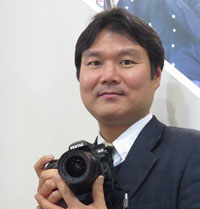
1st Product Planning Group Strategic Product Planning Dept. Global Marketing Division
Ricoh Imaging Company, LTD.
During the CP+ photography tradeshow in Japan, Imaging Resource publisher and editor-in-chief Dave Etchells met for interviews with executives from some of the best-known brands in the camera business. Now that he's back on home turf, the mammoth task of transcribing all these great interviews is well and truly under way.
To follow our Nikon and Canon interviews we published earlier, we have a long interview with the fine folks at Ricoh. Dave sat down with Mr. Takashi Arai, a member of the 1st Product Planning Group in Ricoh Imaging Company's Global Marketing Division, for a discussion about all things Ricoh and Pentax, from the pocketable Ricoh GR to the innovative Shake Reduction-based low-pass filter technology on the Pentax K-3, as well as the unique Ricoh Theta 360-degree camera and lenses for their medium-format 645D cameras.
DE: I'll start with a very broad question about the Ricoh Pentax merger. Some time has passed now, and I'm curious, to what extent has the engineering merged between the two companies? Is there now a single engineering group, or are there still separate groups concentrating on the two brands?
Mr. Takashi Arai, Ricoh: It's already been some time, and the development team is now one.
DE: There's one development team for both?
Ricoh: Yes, in Tokyo.
DE: Ah. I imagine there is some technology on both sides that the other company didn't have; can you tell us anything about how the two companies - the colloquial phrase would be “cross-pollinated” - what technology was exchanged between them?
Ricoh: For example, Ricoh had the GR - the GR is the name of a camera, but the GR camera also has a lot of new Ricoh technology in it. That has also been used in Pentax-branded cameras. And the other direction also; for example, the camera mode TAV is a unique on Pentax cameras, but now this mode is also available on the new GR. This sort of technological specifications exchange has been done already.
DE: So that's an example of a specification that's been shared.
Ricoh: Yes.
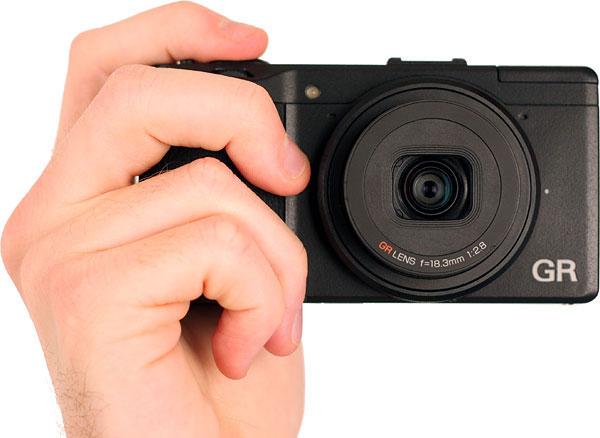
DE: You said the GR is not just the name of a camera, but is also the name of a group of technologies?
Ricoh: Yes, GR is the name of the camera; but the GR has unique functions as well - for example, multiple white balance. That technology was originally used on the GR, but is now also available on the new K3.
DE: That was an area where maybe Pentax had a little more trouble in the past, with white balance, especially under strong-hued light sources, but the K3 is now very good.
Ricoh: Thanks very much!
DE: We've also been very, very impressed with the low pass filter simulation on the Pentax K-3. In fact, that received an Award of Distinction in the Technology of the Year category this last year on our website. We had our annual Camera of the Year awards, and gave the K-3's LPF simulation technology an Award of Distinction
So we've been very impressed with it, and I'm curious - can you describe anything about how the idea for that originated, and how it was developed? Can you tell any of that story?
Ricoh: The idea was there many years ago. Because Pentax is using anti-shake technology that moved the sensor itself - unlike other competitors like Canon and Nikon - we had the technical seed for the LPF simulation already. For example, four or five years ago, people didn't so much mind about the moiré, or...
DE: Or getting rid of the low pass filter.
Ricoh: Yes. Recently, Pentax launched the 645 without using AA filters [anti-aliasing filters, another term for low-pass filters] and other competitors like the Nikon D800E as well, so the market is now more curious, more …
DE: Interested, focused?
Ricoh: Yes, maybe more aware: The market is already aware that an AA filter is nice, but the AA filter also is a limiting factor on the image quality. That was one of the triggers for us to put that function into the new model.
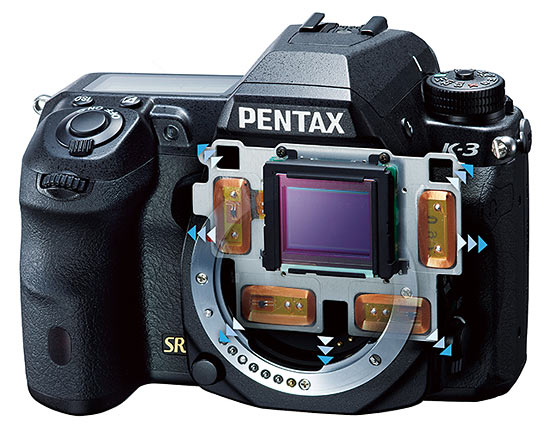
DE: It was such different thinking, though - a number of people have the sensor-based IS, but until Ricoh/Pentax did it… Like I said, it's one of those ideas that seem obvious once you've seen it, but to think of doing in in the first place is a real accomplishment.
Ricoh: Also, the K3 is using a special servomotor to precisely control the movement of the IS-cell unit. Without using that, it would have been impossible to implement that function, because it moves while it's doing the anti-shake function -
DE: So it has to execute all the movement required for shake reduction, but also has to super-impose this very high-frequency/low amplitude oscillation on top of that.
Ricoh: Yes.
DE: So, it basically took a different servo controller to be able to do the two at once, is that part of what you're saying? (Note that I'm distinguishing the controller from the motor itself, the servo actuator. It needed a new, stronger actuator but also needed a different controller?
Ricoh: I don't know to what extent I should explain [expressing concern about going too far into proprietary information], but what has been changed from the K5 to the K3 is the servo controller and the strength of the magnetics. Because of those two, it's now possible to make that action.
DE: I guess that explains another question I have: Because it requires both stronger magnetics and this special controller, that's not something you can really add by firmware change to previous models.
Ricoh: No, it is hardware related.
DE: Going forward, though, since the drive coils and the circuitry and the controller are already part of your bill of materials, it seems there shouldn't be much additional cost to add that capability to cameras in the future. I'm wondering, can we expect to see that technology show up in entry-level cameras at some point?
Ricoh: We are making an effort to make it cheaper and less costly, because shake reduction by sensor shift is one of our advantages, so we want to have that advantage even on the entry class SLRs. So that is our wish, we'd like to also have it on other levels of cameras for Pentax.

DE: This may be too much technical depth to get into, but we measured the frequency of the oscillation in the K3, and it's right about 500Hz. The system is supposedly usable to 1/1000 shutter speed, and I'm wondering, doesn't it lose some effectiveness at exposure times that short, because it's moving at 500Hz, it doesn't have time to make a full cycle of 1/1000 second? So it's specified to 1/1000 second, but maybe it's not as effective at 1/1000, better at 1/500?
Ricoh: It's true that the unit moves, and it makes a small turn less than 1/1000. If you use a faster shutter speed, then it is still effective, but the effectiveness is less because the exposure finishes before it does a full oscillation.
[This wasn't quite the answer I was looking for, as it didn't really address what would seem to be more limited sensor motion in 1/1000 second. If the frequency of vibration is 500 Hz, and the resulting motion was more or less circular, in 1/1000 second, the motion would trace a semicircle. So you'd have roughly half the anti-aliasing effect you'd get at shutter speeds of 1/500 and below. (Actually, slightly more complicated than that, but you get the idea…) I didn't want to bog the interview down on a fine technical point, though, so moved on.]
DE: In the current mode for still photography, it moves a small amount very quickly; I'm wondering, would it be possible to develop a video mode to make a video low-pass filter, where it would make larger oscillations, but more slowly? In videography, often you don't really want to use a very fast shutter time, because it makes it very choppy-looking. Instead of doing just a pixel movement at 500Hz, could it do a larger movement at 60Hz or 140Hz? Is that something you're looking at as a possibility?
Ricoh: There are two answers - one is that, even still shots, if you use a longer shutter time, then the oscillation frequency is also slower. It doesn't have to be 500Hz, 500Hz is a maximum speed.
DE: Interesting. We were just measuring it at one particular shutter speed, but if you use a slow shutter speed -
Ricoh: With a slow shutter, the movement will also be slower slow - that is for still. That means it also possible, speed-wise, to use that function in a movie; but to use it for movies, we have to deal with some other issues. For example, it makes a small noise, and also raises issues with heat or battery exhaustion. It's not as easy as you may think. One day, if we can develop a better solution, then it will be used on movies - not now.
DE: A key would be to get the noise out, that's a really primary thing.
Ricoh: That is one, yeah.
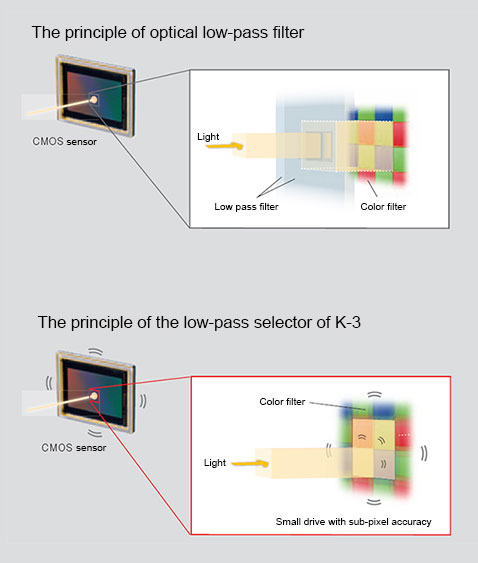
DE: And also the heat. We noticed that, when you go to take a picture, it just starts up just a bit before the shutter fires, then shuts down shortly after. I guess that's to minimize the amount of energy it takes, and the amount of heat it generates.
Ricoh: Right.
DE: Interesting. I asked about that, because video aliasing is a big problem for everybody with SLRs. You don't have enough data transfer speed or processing power to clock all the pixels off and then sub-sample, so DSLRs just skip lines. That means, even if you have a low-pass filter suitable for still images, it's not effective for video. I'm thinking this might be a way around that, so it could be a significant benefit.
Ricoh: Yes, as long as we can deal with the other issues.
DE: Also talking about shake reduction - at the time of the announcement of the K3, we were told that there was a separate controller dedicated just to shake reduction, as well as those stronger actuators. But it seems like the K3 is actually rated 3.5 stops, whereas the K5 II was 4 stops. I'm wondering, does that have to do with switching to the CIPA standard for characterizing IS?
Ricoh: That's correct, we now use the CIPA standard way of describing IS effectiveness, but the actual result you get from a K3 is better than K5.
DE: So based on the CIPA standard, maybe the K5 is three stops?
Ricoh: Yes, maybe.
DE: Good - yeah, that's what's good about having a standard like that, so that you can really compare. Your Pentax brand has done a really great job of delivering very strong features at very affordable prices. In fact, we named your Pentax K-50 as the Entry-Level Camera of the Year for last year. How has the market been responding to it? Is it meeting your expectations for sales, or exceeding them, or is it hard to say?
Ricoh: I believe the market reaction has been very good. It's a camera that is designed for entry-level users, but even so, it boasts water-resistance, two-dial control ability, and so on. It has all of the functions available in the middle range and higher range amateur models. We got good reviews for those functions, and those reviews also promote or encourage entry-level users who are looking for better cameras.

DE: So, because it has all those features - it's not just interesting to entry-level users, but even more advanced users would be interested in it.
Ricoh: That's right.
DE: And if the K50 is a great deal, the K500 is even more of a bargain because it has almost all the same features, but is not water-resistant. I'm curious how the sales look between them - is the K500 selling more? Is the K50 selling more? Or does it depend more on what part of the world you're looking at?
Ricoh: The sales volume is better on the K50.
DE: Really, it's better on the K50? I wasn't expecting that, because the K500 seems like such a bargain.
Ricoh: The K500 is a special model, which is not available in all markets; it's available in some markets and for some accounts. For example, Japan is not selling K500 at all.
DE: I see. I think in the U.S. it might be the K500 is just with some very large accounts, maybe, or the electronics stores, something like that.
Ricoh: Yes, perhaps.
DE: Turning to the Ricoh brand of cameras for a moment - the GXR and GR Digital 4, they're both still listed on the Ricoh Imaging site but, at least in the United States, they appear to be out of the market. Are those products actually end of life, or are they still being produced?
Ricoh: Production has been already finished, and so sales are up to the market. It's a matter of selling the remaining inventory.
DE: In the fixed lens marketplace, the Ricoh GR seems to be a very strong product. I have one here. [I had one in my camera bag.]
Ricoh: Thank you.
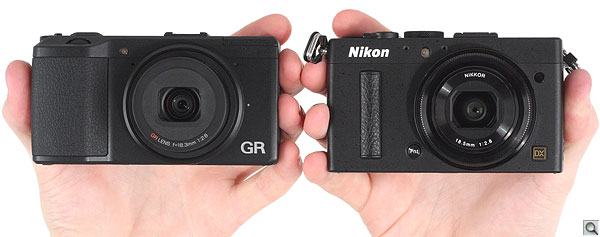
DE: How has it been received by the market? My sense is, the fixed prime lens camera market is fairly small, overall. I'm wondering, is there really enough demand there to justify continued development? How has it been received, and is there enough demand for that sort of product to continue developing in that area?
Ricoh: Demand is there, the GR has a good lens and we've been receiving lots of requests. When we launched the GR 4, it had a smaller sensor, but now the GR has an APS-C sensor - a bigger size sensor. Even though the camera itself is not as big as a lot of cameras. For those looking for a compact camera with better image quality, the GR is one of the best cameras. The market is still there. What we know is, cameras with those kind of specific characteristics - lens shutter cameras - have a strong sales point, like the GR. It's not just Pentax, but I think it's the same story with all of the camera manufacturers.
DE: Everybody is enjoying good sales in that category?
Ricoh: Yes.
DE: Ah, that's good to know. One area where I think there has been good success in the fixed lens market is the category of small cameras with larger sensors, but with zoom lenses, vs. primes. I'm wondering, is that a direction that you're considering for the GR line? Would it make sense to have a GR with a zoom lens?
Ricoh: Actually, we also have requests or a wish list from users for a GR with a zoom? Maybe that is one of the directions the GR digital could take, but we don't have any specific or fixed R&D plan for a GR Digital zoom. Not yet.
DE: So you've heard that request from consumers, but you haven't specifically made plans to do that yet?
Ricoh: That's right.
DE: Turning to a completely different product, the Ricoh Theta - the 360 degree panoramic camera - it's very unique. It only does one thing, makes spherical panoramas, but there's really nothing else like it on the market. How has that been received? How are people reacting? How has the market been receiving that? For instance, I would think it would be a natural for people in real estate, taking pictures of rooms and things.
Ricoh: Yes, the reaction from business users, b2b users, is bigger than we had expected.
DE: Oh, really?
Ricoh: Yeah.
DE: So it's a business play, rather than just consumers.
Ricoh: For example, real estate or construction agencies, those kinds of people. There are a lot of applications for it which have been invented by the end-users. For example, the family users - he or she has a newborn baby, and they take pictures of the baby, and as you know, all the surroundings around the baby are also in the picture. Once the baby grows up, then he can see his parents faces, or what was surrounding him in that baby bed.
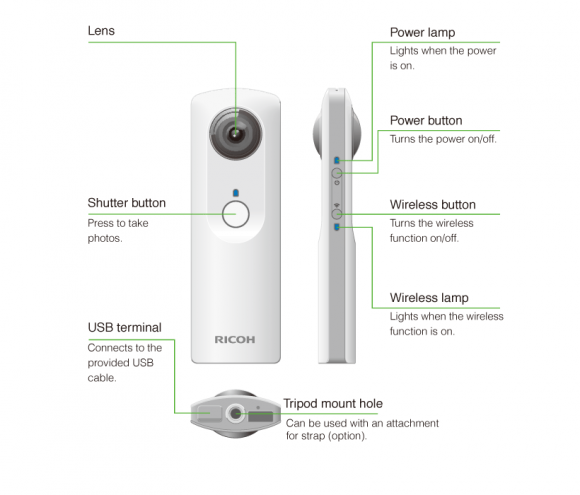
DE: Yeah, yeah, so it's not just the baby - it's the room and the parents, the whole experience of that time. That's interesting, that makes sense.
Ricoh: We really didn't expect that, when we launched this product, so there are a lot of new applications.
DE: Yeah, that never occurred to me - you think of taking baby pictures, you take them for yourself. Those baby pictures are for the baby, too.
Ricoh: Yes. (chuckles)
DE: We haven't received a review sample of the camera yet, so I'm unfamiliar with some of the details. How do you view the images on your computer? Is there a viewer application that comes with it? I know you can upload and view online, but is there software that comes with the camera, so you can view on your PC?
Ricoh: The box of the Theta doesn't hold any software at all - what you need is to download the app for Android or iOS. Also, it's now available for Windows and Mac.
DE: And that lets you view the images locally, without connection to the external server? Or do you still have to be connected to the server?
Ricoh: You need to upload it to the server.
DE: That's the only way to see them, is by uploading.
Ricoh: Yes. Then, once you upload, you can share the images.
DE: I would think especially for business applications, people would want to be able to have local ownership or a local copy of the image that they could then view. Have you heard that request from the market at all, to have a local-only viewer?
Ricoh: We did an update at the very end part of January, that makes it possible to attach the Theta image onto an email, and you can send that to whomever you want to share with.
DE: Ah, so basically that image has an embedded viewer in it, so when the person receives it, they can click on it and it will open up.
Ricoh: By using Google Plus, it's possible to exclude people or make the images private.
Ricoh: That is actually out of my product area, so I'm afraid I'm not so familiar with that product. (laughs)
DE: This isn't your product area, yeah. That probably answers one of the other questions that I've heard, is that at least previously, it was necessary to have a Facebook account in order to logon to the server; but we've been hearing complaints from people saying they don't want to have to use Facebook. It's okay to logon to the server, but they don't want a Facebook account. Is that possible now, to log on without Facebook? (I guess if you can email images to somebody, then they at least don't need Facebook.)
Ricoh: In the early time after the Theta was launched, that was true; the Theta used to need an account on Facebook or Twitter or Tumblr - one of those three.
DE: So one of those three, not just Facebook. It was Facebook, Twitter or Tumbler?
Ricoh: Yes. But that was really early stage, but now, as I explained to you, Google Plus is also supporting Theta. Also, Google Maps.
DE: Ah yes, Google Maps - I think I saw that news item on our site.
Ricoh: In fact, you can make Google Street View!
DE: Yeah, make your own Street View, that sounds kind of cool.
Ricoh: Yes, even within your house or garden, where the Google cars never go.
DE: Going back to the Pentax line - every time I let our readers know that I'm going to do an interview with someone from Ricoh or Pentax, they always ask about full-frame K-mounts, full-frame K-mounts.
Ricoh: *laughs*
DE: Isn't that true?
Ricoh: That's true.
DE: The answer is usually something like, “We're looking into it, we'll do something when we think the time is right.” Can you give me any more insight than that? Is the time getting closer to being right?
Ricoh: *laughs* Still we are -
DE: Still you're looking.
Ricoh: Yes, looking for a good time to launch full-frame. At the present time, we are stronger on medium format cameras - that is one of the reasons why we developed prototypes for the 645.
DE: Yeah, certainly you have a very, very strong position there - excellent features, great image quality and very competitive pricing compared to a lot of the other medium format offerings. It really makes sense, to put resources there. Somewhat related to the question of resources though - as an entirely new camera line with its own set of lenses, the Q series must have taken a lot of resources to develop. That line has gotten, I think, very little traction in the U.S. Is it doing well in Japan, other Asian countries, Europe?
Ricoh: The observation is true, that we are not so strong in the U.S. market with the Q, but it has strong demand, at least in the Japan and Asian markets.
DE: In Japan and the Asian market, I see. So it makes sense to do that for that market; you can sell many of them there.
Ricoh: Yes.
DE: I mentioned that you showed me the wood block of the super wide angle lens for the 645DF, and that was one of my questions; it currently has a very limited lens selection - there are only three new lenses. A lot of people buy lenses on eBay, obviously, but -
Ricoh: Three new lenses for the 645?
DE: No, there's three current lenses that you're manufacturing, right? For the 645? Are there more lenses for the 645D?
Ricoh: We do have more than three lenses.
DE: Oh, there are? That's interesting - when I looked at the Imaging site, I thought I only saw three listed.
Ricoh: The lenses for the 645 - the lens available after the 645D was announced, yes, there are three since then. But we do have a long history of 645 analog cameras. Those lenses also are attachable.
DE: Are you still manufacturing those lenses?
Ricoh: Yes, we are. Of course, when we launched the 645D, we did a precise test to determine if those analog lenses could be used also for the digital, and according to our tests, it should be no problem.
DE: I'll have to check again, but I think I went to the Ricoh Imaging site, and they had a list of all the lenses, but I only saw three 645s at the very bottom, but maybe - could be that they're not imported to the U.S. maybe? I can ask the U.S. people about that.
Ricoh: (chuckles) We'll have them upload all the lenses. Thank you.
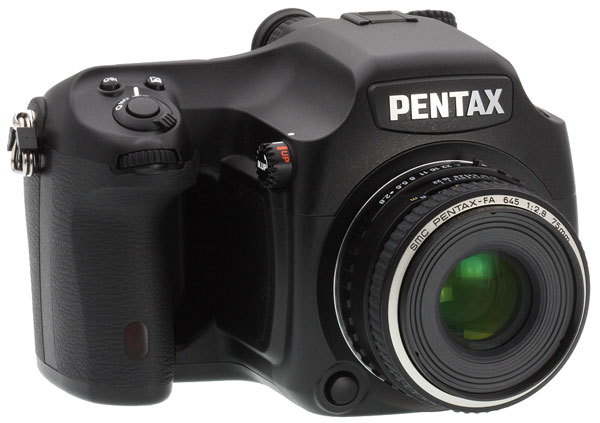
DE: Ah, OK, thanks, good to know! You announced the super wide - what was the timeframe for that again? Was that May or something?
Ricoh: The camera is to be launched in Spring; as to the lenses, we didn't announce anything.
DE: I think that's the only one that you're announcing. You don't have a lens roadmap for the 645 that you can share, even a fairly non-specific level? Just you know - longer telephoto, that kind of thing?
Ricoh: The 645 lens map is available on the website, and also at the booth.
DE: Ah, okay. So, just three questions left that I'll ask you to look into your crystal ball for.
Ricoh: *laughs*
DE: So after years of seeming immune to the general downturn of camera sales, the interchangeable lens camera market in the last six to 12 months took a dip. It seemed to catch everybody by surprise. Do you think this is a short-term issue driven by economic factors, or do you think it's part of a longer term trend? I said it was crystal ball, right?
Ricoh: Right, we need a nice crystal ball! (chuckles) You said for DSLR, or all cameras?
DE: Compacts, point-and-shoots have been declining very sharply, but until now, the interchangeable lens cameras have been going up or staying level. Last year, I heard that they dropped about 15%. I'm wondering if you think that that's something having to do with global economy, or is it something more structural about how the market has matured?
Ricoh: Our expectation or our observation or whatever is that SLRs declined last year, that's true. For the future, though, that will be stable. Compact cameras have been already been replaced with smart phones, so for sure the compact camera segment will be declining. A camera like this, or a camera like mirrorless should be more stable.
DE: So you think the interchangeable lens market has dropped some, but that it will level out?
Ricoh: That's right.
DE: That was part of another question - longer term, do you think we'll have a soft year or two, and then it picks up? Or it does it seem like the prediction is relatively flat.
Ricoh: The demand for taking better images, taking more creative images, will be there. Demand for taking the image, like daily photography, can be replaced with other things. But the camera will survive.
DE: Yeah. One thing I'm thinking, though, is that SLRs - very early SLR image quality wasn't so good compared to now, but image quality now is so good, improvements next year - two years, three years - is maybe not such a big difference. I'm wondering, if perhaps people won't upgrade as often, once they reach that point, where the cameras are "good enough"?
Ricoh: That is also true, so we need other reasons for people to purchase a new camera; otherwise, the current camera has enough image quality, and is good enough. That's true. For example, the interchangeable lens market is still there, but needs to go farther. For example, our camera has a water resistant capability, or is cold-proof, or has better movie functions - there are still many, many opportunities or possibilities to update the camera capabilities.
DE: So you think for a considerable time, you'll be able to continue giving people reasons to upgrade?
Ricoh: Yes.
DE: Actually, I said those were my last three questions, but a reader question came in - he was interested in what we call a “birding type lens” for taking pictures of birds; a very long telephoto, like a 400mm f/5.6. He says, “What's the deal with such a paltry offering?" Do you have it on your roadmap, to go to very long telephotos?
Ricoh: We already have a 560mm - a very long, super telephoto prime lens. And now, we also have on our roadmap, we already announced that we would have a longer-range zoom.
DE: Okay. And of course, you just announced the rear converter, so that takes your 300mm to a 420mm, 1.4x, right.
Ricoh: Yes.
DE: This is the very last question, this is kind of part of an earlier one - a reader asked, he's interested in the sensor shake system of the K3; will it be implemented on upcoming Pentax and Ricoh cameras? I guess that might be asking on the Pentax side, the question that I asked of is it going to be available for more modest price points like the K50 type camera? Is that a technology that would be of interest, or would it even fit into a camera like the GR?
Ricoh: The GR is very challenging; the idea of the GR is for it to be smaller -
DE: The camera needs to be small, and the IS system takes space.
Ricoh: Yes. We need to develop lots of technology before that will be possible.
DE: And you kind of already answered the question about lower-end cameras, it has an incremental cost associated with it now, and you're working to reduce that.
Ricoh: That's right.
DE: That's actually all of my questions. I appreciate your time very much. It's been a very interesting discussion, I think our readers will be very interested in the things we discussed.
Ricoh: Thank you very much, it was my pleasure.
(A background note from Dave: I have a huge amount of material from my recent trip to Japan, awaiting digesting and writing up. It's been terribly delayed, though, first because I spent a full week after the recent CP+ show traveling within Japan, collecting additional material from facility tours and on-site interviews with various companies. Then, on my last night in Tokyo, I managed to break my foot(!), requiring significant surgery to repair it upon my return to the US. That resulted in the loss of another week or so to the ministrations of Percocet, and I've had a tremendous amount of catchup on emails and the general running of Imaging Resource as a result. I'm finally back functioning now, only to learn that I have a jury duty assignment starting Monday that I'm not sure I can get deferred until I'm fully ambulatory again. Rest assured, though, I'll be working to digest all the material I've collected and to post it up as a series of articles as quickly as I can - it's just unfortunately still not clear how quickly that will be able to happen. It's killing me, though, as I have an enormous treasure trove of material from this trip, almost 10.5 hours of highly technical interviews and disussions, the raw material for many, many articles about camera and lens technology, and the state of the industry. So stay tuned, and bear with me, I promise it'll be worth the wait! For now, though, on to my interview with Ricoh/Pentax...)